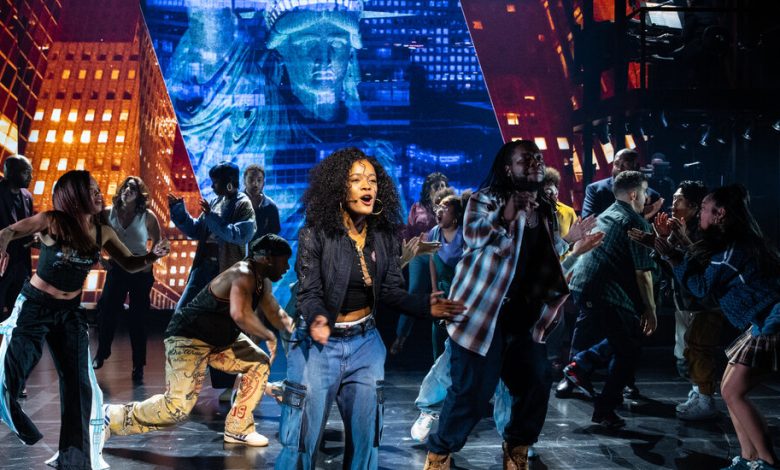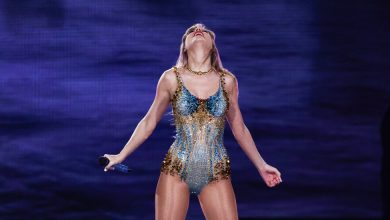‘Hell’s Kitchen’ Review: How Alicia Keys Got Her Groove

Even in the Golden Age of musical theater, shows so commonly died after intermission that critics came up with a name for the disease. “Second act trouble” presented in many ways: unmoored songs, desperate cutting, illogical crises, hasty workarounds. Yet all those second act symptoms arose from the same underlying condition: first act ambitions.
So it’s not really surprising that an enormously ambitious new musical like “Hell’s Kitchen,” the semi-autobiographical jukebox built on the life and catalog of Alicia Keys, disappoints after the mid-show break, tumbling directly into the potholes it spent its first half so smartly avoiding. What’s surprising in this promising show, which opened at the Public Theater on Sunday with the obvious intention of moving to Broadway, is how thrilling it is until then.
Surprising to me, anyway. I find that jukeboxes — especially biographical ones, like “Motown” and “MJ” — almost inevitably add to the ordinary difficulties of musical construction with difficulties unique to their provenance. The involvement of the original artists (or their estates) leads to historical sugarcoating. A rush to hit all the high points results in a cherry-picked résumé. The catalog retreads, written for a different reason, fail to move the action forward. And since those songs are the show’s selling point, they wind up wagging the story.
But Keys, working with the playwright Kristoffer Diaz and the director Michael Greif, steps around most of those pitfalls in the show’s first hour, setting up the story with notable verve and efficiency. In neat succession it introduces the main characters (17-year-old Ali and her single mother, Jersey), the primary setting (the Midtown Manhattan neighborhood of Hell’s Kitchen in the late 1990s), the parameters of the plot (Ali’s thirst for love and art) and an imminent source of conflict (Mom).
At the same time, it floods us with music to establish the worlds it’s taking us into, well beyond the R&B and pop that Keys is best known for. In a marvelous elevator sequence, Ali encounters opera, jazz, merengue and classical piano as she descends from the one-bedroom 42nd-floor apartment she shares with Jersey, a sometime actor juggling two jobs. (The building, Manhattan Plaza, offers affordable housing for artists.) Then, when Ali reaches the street, a giant rush of sound enfolds her; all of New York, it seems, is singing, playing and, in Camille A. Brown’s excitingly contextual choreography, dancing.
We are only a few minutes into the show and its armature is fully in place. We know that this is going to be a mother-daughter love-and-letting-go story, as Jersey (Shoshana Bean, warm and pyrotechnic) tries to keep Ali fed and safe. Though race isn’t explicitly an issue between them, Jersey is white and Ali is biracial, and Ali (Maleah Joi Moon in a sensational debut) will gradually be drawn away from her mother’s smothering by the wider group of people she encounters.
One is the classical pianist, Miss Liza Jane (the magisterial Kecia Lewis), who will demand that Ali take lessons from her — though in truth Keys started studying at 7, not 17. And out on the street, to the strains of the 2003 hit “You Don’t Know My Name,” Ali will flirt with a bucket drummer named Knuck (Chris Lee, sweet as pie) even though he’s in his mid-20s. He’ll resist — at first.
And so, over the course of 11 songs, the first act does the work of ambitious first acts everywhere: expanding the show’s horizon to the larger world in which the action takes place (not a fair world for young Black New Yorkers) and deepening our knowledge of the main characters through conflict. Also humor: Diaz — whose hilarious professional wrestling play, “The Elaborate Entrance of Chad Deity,” was a Pulitzer Prize finalist — saves the story from too much earnestness. Credit Greif, too, whose steady management of tone and tension coaxes drama from a tale that could easily have been too interior.
Together with Keys they also solve, or at least delay, many of the jukebox problems. By keeping a very narrow focus on just a few weeks in Ali’s life, “Hell’s Kitchen” chooses the possibility of dramatic depth over career highlights. Nor is there much sugarcoating: Keys seems quite willing to present her ambitious stand-in as a hormonal teenager immune to common sense — and Moon, 21, is precociously clever and fearless in delivering that complex portrait.
Most important, Keys’s songs, even hits like “Fallin’,” “If I Ain’t Got You” and “No One,” fit into the story (and into the mouths of a variety of characters) without too much jimmying. If they don’t, the situation is acknowledged effectively. When Ali finally does spend the night with Knuck — right on time, just before the various story lines merge in a dreadful event at the end of the first act — Ali’s friend Tiny (Vanessa Ferguson) is miffed, for this is supposed to be an unapologetically woman-centered story. “The world is hers ’cause she got a man now?” she complains, interrupting the 2012 banger “Girl on Fire,” here repurposed as a joyful “I’m on top of the world” song. “That’s what we’re doing?”
Alas, “that’s what we’re doing?” is how I felt the moment the second act started. As if the creators had run out of time for finesse — though Keys and Diaz have been working on “Hell’s Kitchen” for more than a decade — its wit curdles into lectures as the story, especially Jersey’s, goes blurry. Her strained relationship with Ali’s father, here a jazz pianist though in reality a flight attendant, bears the characteristic signs of dramaturgical whiplash. (On the other hand, he’s played by Brandon Victor Dixon, a human aphrodisiac, vocally and otherwise.) An argument between Jersey and Miss Liza Jane feels similarly trumped up, until it is resolved in an obvious twist of pathos. And despite Bean’s skill, Jersey’s love for her daughter, the core of the show, gets lost in the attempt to complicate it.
The second act songs follow suit; it is no coincidence that the three new ones Keys wrote for the production, all good, are at the top of the show. And though well-structured musicals typically have far fewer songs in the second half than the first to make way for the complexities of plot resolution, here there are a whopping 14, ending indulgently if unavoidably with the 2009 New York anthem “Empire State of Mind.” As a result, “Hell’s Kitchen” nearly becomes what it tried to avoid at the start: a hit dump.
But because those hits are hits for a reason, there is still pleasure in hearing them. The singing, arrangements and orchestrations (by various hands including Adam Blackstone, Tom Kitt, Dominic Follacaro and Keys herself) are thrilling, if strangely unbalanced in Gareth Owen’s sound design. The fire-escape sets (by Robert Brill), expressive projections (by Peter Nigrini), saturated lighting (by Natasha Katz) and often hilarious costumes (by Dede Ayite) are all Broadway-ready.
I hope “Hell’s Kitchen” will be too. Of course, many musicals make the transfer without ever solving their first act problems, let alone their second. That would be a shame here. Though not perfectly told, Ali’s discovery that art is love, with or without the guy, is too rich not to reach a bigger audience, and a million more girls on fire.
Hell’s Kitchen
Through Jan. 14 at the Public Theater, Manhattan; publictheater.org. Running time: 2 hours 30 minutes.




